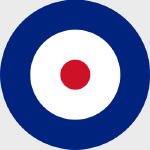Corgi AA28603 RAAF Bristol Beaufighter TF.X Torpedo Bomber - NE775/X2, No.455 Squadron, RAF Langham, Norfolk, England, June 1944 (1:72 Scale)
"Strike and strike again"
- Motto of No.455 Squadron
 Developed as a private venture by the Bristol Aeroplane Company, the Beaufighter was a two-seat all-metal fighter using components from the Beaufort torpedo-bomber. First flown on July 17th, 1939, the Beaufighter eventually equipped 52 RAF squadrons, giving outstanding service during World War II, in particular as a night-fighter and torpedo-bomber (where the aircraft were affectionatey known as 'Torbeaus').
Developed as a private venture by the Bristol Aeroplane Company, the Beaufighter was a two-seat all-metal fighter using components from the Beaufort torpedo-bomber. First flown on July 17th, 1939, the Beaufighter eventually equipped 52 RAF squadrons, giving outstanding service during World War II, in particular as a night-fighter and torpedo-bomber (where the aircraft were affectionatey known as 'Torbeaus').
Entry into Fighter Command service came during August 1940 with the Fighter Interception Unit at Tangmere. The following month, five squadrons received the Mark 1F equipped with Mark IV Air Intercept radar for night-fighter duties although the type's first kill wasn't until November of that year. The Beaufighter continued as a night-fighter until 1943, and the last aircraft (a TT10) was not retired from RAF service until 1960, nearly 21 years after the type's first flight.
1941 saw the development of the Beaufighter Mk.IC long-range heavy fighter. This new variant entered service in May 1941 with a detachment from No. 252 Squadron operating from Malta. The aircraft proved so effective in the Mediterranean against shipping, aircraft and ground targets that Coastal Command became the major user of the Beaufighter, replacing the obsolete Beaufort and Blenheim.
Coastal Command began to take delivery of the up-rated Mk.VIC in mid 1942. By the end of 1942, Mk VICs were being equipped with torpedo-carrying gear, enabling them to carry the British 18-inch or the US 22.5-inch torpedo externally. The first successful torpedo attacks by Beaufighters came in April 1943, with No. 254 Squadron sinking two merchant ships off Norway.
The Hercules Mk XVII, developing 1,735 hp at 500 feet was installed in the Mk VIC airframe to produce the TF Mk.X (Torpedo Fighter) - commonly known as the "Torbeau." The Mk X became the main production mark of the Beaufighter. The strike variant of the "Torbeau" was designated the Mk.XIC. Beaufighter TF Xs would make precision shipping attacks at wave-top height with torpedoes or rockets. Early models of the Mk Xs carried metric-wavelength ASV (air-to-surface vessel) radar with "herringbone" antennae carried on the nose and outer wings, but this was replaced in late 1943 by the centimetric AI Mark VIII radar housed in a "thimble-nose" radome, enabling all-weather and night time attacks.
The North Coates Strike Wing (Coastal Command), based at RAF North Coates on the Lincolnshire coast, developed attack tactics combining large formations of Beaufighters on anti-flak suppression with cannon and rockets while the Torbeaus attacked on low level. These tactics were put into practice in mid 1943 and in a 10 month period 27,000 tonnes of shipping were sunk. Tactics were further adapted when shipping was moved from port during night hours. North Coates Strike Wing operated as the largest anti-shipping force of the Second World War, and accounted for over 150,000 tons of shipping and 117 vessels for a loss of 120 Beaufighters and 241 aircrew killed or missing. This was half the total tonnage sunk by all strike wings between 1942-45.
Pictured here is a 1:72 scale Royal Australian Air Force Bristol Beaufighter TF.X torpedo bomber that was attached to No.455 Squadron, then deployed to RAF Langham, Norfolk, England, during June 1944.
Now in stock!
Dimensions:
Wingspan: 9-3/4-inches
Length: 7-inches
Release Date: March 2024
Historical Account: "The ANZAC Strike Wing" - No.455 Squadron was employed in largely uneventful anti-shipping and anti-submarine patrols during this time. On January 28th, 1943, seven aircraft from Nos.455 and 487 Squadrons sank a 3,570-tonne merchant ship with torpedoes; while a 6,018-tonne merchantman was sunk near Egero Island on May 12th. Further success followed, with a Hampden destroying the German submarine U-227 north of the Shetland Islands on April 30th. Moving to RAF Leuchars in Scotland, the squadron was re-equipped with Beaufighters in October 1943, and operated against German shipping off Norway and in the Baltic Sea until the end of the war, forming the "Anzac Strike Wing" with No.489 Squadron, Royal New Zealand Air Force. The squadron moved to RAF Langham in Norfolk in April 1944, subsequently providing flak suppression for No.489 Squadron's torpedo carrying Beaufighters. Commencing operations on May 6th a number of enemy ships were attacked, successfully sinking one. During these operations the Australians faced heavy naval anti-aircraft fire as well as enemy fighters. Often attacking targets in narrow Norwegian fiords, they suffered heavy casualties.
In October 1944, the squadron moved to RAF Dallachy, in Scotland. On November 8th, 1944, six No.455 Squadron Beaufighters took part in an attack on German shipping in Midgulen Fiord, sinking two ships despite heavy anti-aircraft fire. Anti-shipping strikes continued into 1945, and saw the destruction of a number of vessels. The squadron moved to RAF Thornaby, from where they were involved in attacks on German shipping in the Baltic Sea. The squadron's final operation of the war was flown on May 3rd, 1945, when they attacked two German minesweepers in concert with New Zealand aircraft which sunk a tanker. No.455 Squadron was disbanded on May 25th, while at Thornaby. Australian losses amongst the squadron's personnel during the war amounted to 91 killed. Between April 1942 and the end of the war, it was credited with sinking 18 vessels: one U-boat, 10 merchantmen, three escorts and four minesweepers.









